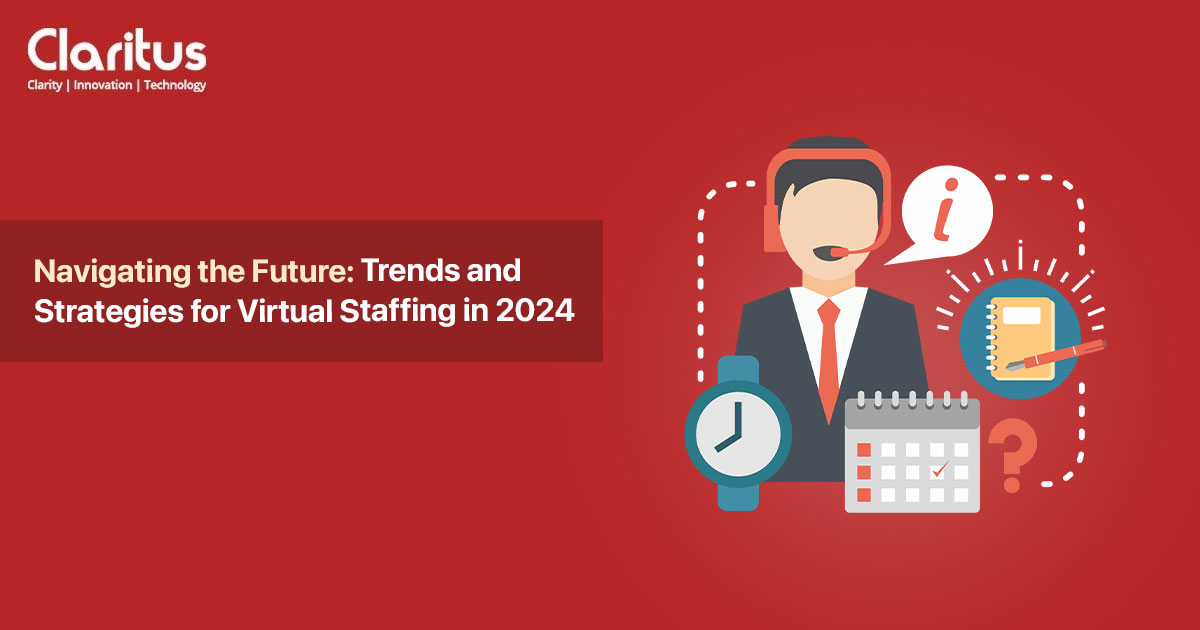Navigating the Future: Trends and Strategies for Virtual Staffing in 2024

In the ever-evolving landscape of the modern workplace, virtual staffing has emerged as a vital component for businesses to thrive in an increasingly digital world. As we step into 2024, the dynamics of virtual hiring continue to evolve, influenced by technological advancements, shifting workforce preferences, and global trends. In this blog, we’ll explore the key trends and strategies shaping virtual staffing in 2024, and how businesses can leverage them to build efficient and productive remote teams.
1. Embracing Remote Work Culture: The adoption of remote work has skyrocketed in recent years, accelerated by the COVID-19 pandemic. In 2024, businesses are not just accommodating remote work; they are actively embracing it as a core aspect of their company culture. To thrive in this environment, organizations need to foster a sense of belonging and collaboration among virtual teams. Strategies such as regular virtual team-building activities, transparent communication channels, and investment in remote work infrastructure can significantly enhance employee engagement and productivity.
2. Leveraging AI and Automation: Artificial Intelligence (AI) and automation technologies are revolutionizing the way businesses approach virtual staffing. In 2024, AI-powered recruitment platforms are streamlining the hiring process, from sourcing candidates to conducting initial screenings. Automated workflows and chatbots are handling repetitive tasks, allowing human resources teams to focus on more strategic initiatives. By leveraging AI and automation, businesses can reduce time-to-hire, improve candidate quality, and enhance overall efficiency in virtual staffing.
3. Prioritizing Diversity and Inclusion: Building diverse and inclusive remote teams remains a top priority for businesses in 2024. Companies are recognizing the value of diverse perspectives and experiences in driving innovation and problem-solving. To foster diversity and inclusion in virtual staffing, organizations are implementing strategies such as blind recruitment processes, diversity training programs, and creating inclusive remote work policies. By prioritizing diversity and inclusion, businesses can attract top talent from a variety of backgrounds and strengthen their competitive advantage in the marketplace.
4. Flexible Work Arrangements: Flexibility has become a cornerstone of virtual staffing in 2024. With employees seeking greater work-life balance and autonomy, businesses are offering flexible work arrangements such as flexible hours, compressed workweeks, and the option to work from anywhere. By accommodating diverse work preferences, organizations can attract and retain top talent while improving employee satisfaction and morale. Flexible work arrangements also enable businesses to access a global talent pool and overcome geographical barriers in virtual staffing.
5. Remote Onboarding and Training: As remote work becomes the new norm, businesses are reimagining their onboarding and training processes for virtual employees. In 2024, companies are leveraging virtual onboarding platforms, interactive training modules, and mentorship programs to facilitate seamless integration and skill development for remote hires. By investing in remote onboarding and training initiatives, businesses can ensure that virtual employees feel supported, empowered, and equipped to succeed in their roles from day one.
6. Cybersecurity and Data Protection: With the proliferation of remote work comes an increased focus on cybersecurity and data protection. In 2024, businesses are implementing robust cybersecurity measures to safeguard sensitive information and mitigate cyber threats in virtual staffing. Strategies such as multi-factor authentication, encrypted communication tools, and regular security audits are essential for maintaining data integrity and protecting against unauthorized access. By prioritizing cybersecurity, businesses can instil trust and confidence in their virtual workforce and mitigate potential risks associated with remote work.
7. Performance Management and Accountability: Effective performance management is critical for driving productivity and accountability in virtual teams. In 2024, businesses are adopting agile performance management frameworks, real-time feedback mechanisms, and objective key performance indicators (KPIs) to monitor and evaluate remote employee performance. By setting clear expectations, providing regular feedback, and recognizing achievements, organizations can motivate virtual employees and align their efforts with business objectives. Performance management tools and software are also enabling managers to track progress, identify areas for improvement, and optimize team performance in virtual staffing.
In conclusion, virtual staffing in 2024 is characterized by a combination of technological innovation, cultural transformation, and strategic adaptation. By embracing remote work culture, leveraging AI and automation, prioritizing diversity and inclusion, offering flexible work arrangements, investing in remote onboarding and training, prioritizing cybersecurity, and implementing effective performance management practices, businesses can navigate the complexities of virtual staffing and build high-performing remote teams poised for success in the digital age. As we continue to embrace the future of work, staying abreast of these trends and strategies will be essential for businesses to thrive in the dynamic landscape of virtual staffing in 2024 and beyond.
Contact us to help you with your requirements: https://www.claritusconsulting.com/virtual-staffing/
